Scaling accessibility awareness at Sage: five years of GAAD
Awareness is one of the fundamentals when creating an accessibility culture, so every year at Sage I marked Global Accessibility Awareness Day (GAAD) in some way, and every year it got bigger and better.
Sage is an international company of nearly 11,000 people across 23 countries, and my mission has been to grow the community to as many of those people as possible; GAAD has proved a great way to do that.
Having organised a meetup that ran for more than five years, as well as two conferences I fell into familiar territory with GAAD.
Year one (2021)
My first GAAD at Sage was in May 2021 and I had been building an accessibility community for about eight months or so by then. We were all mid-pandemic at that point, so it was all online; I delivered three sessions over the course of the day:
- An introduction to accessibility presentation
- An online accessibility empathy lab, where I got volunteers to take control of my computer and carry out tasks with a Funkify impairment simulator activated
- A live coding session on the basics of HTML (headings, lists, etc.) where I demonstrated how the markup I was writing was communicated via screen reader software
Attendance was relatively modest but the sessions worked really well and I received several messages from people who had had their Aha! moment on accessibility.
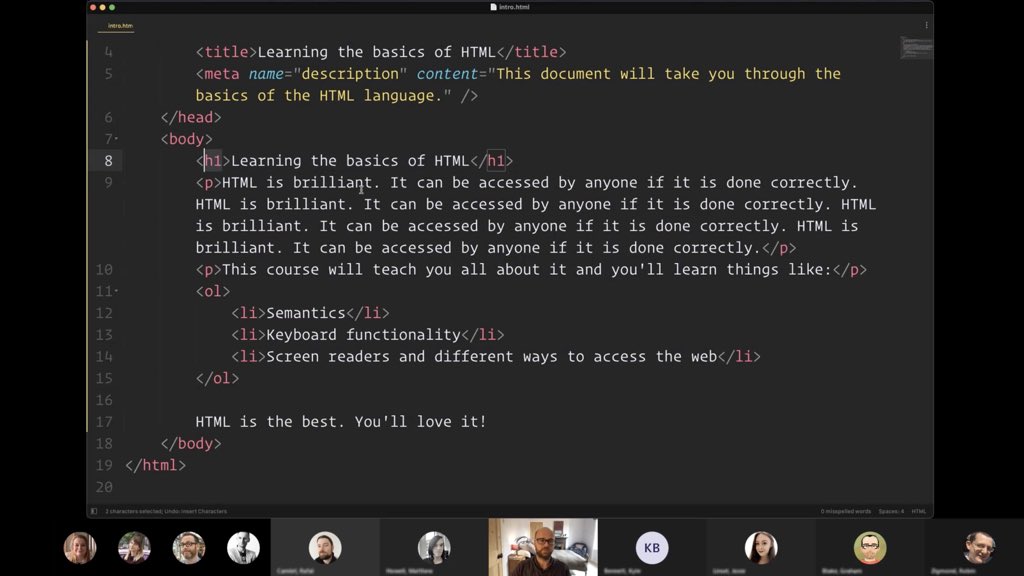
Year two (2022)
The next year I had people asking me ahead of time what was in store. So I decided to go all-out with a full day online conference.
With some lessons learned from the last time round, I did a lot more promotion. I also got colleagues involved in delivering the sessions, and over the course of the day we had:
- An introduction to accessibility
- A Cards for Humanity activity around accessible user research
- A presentation on colour blindness and dyslexia
- A session on how to use accessibility-focused user personas to achieve WCAG compliance
- An accessibility empathy lab
- Another HTML basics session
The day was a success! We had 388 cumulative attendances across all sessions; that’s an average of 65 people per session.
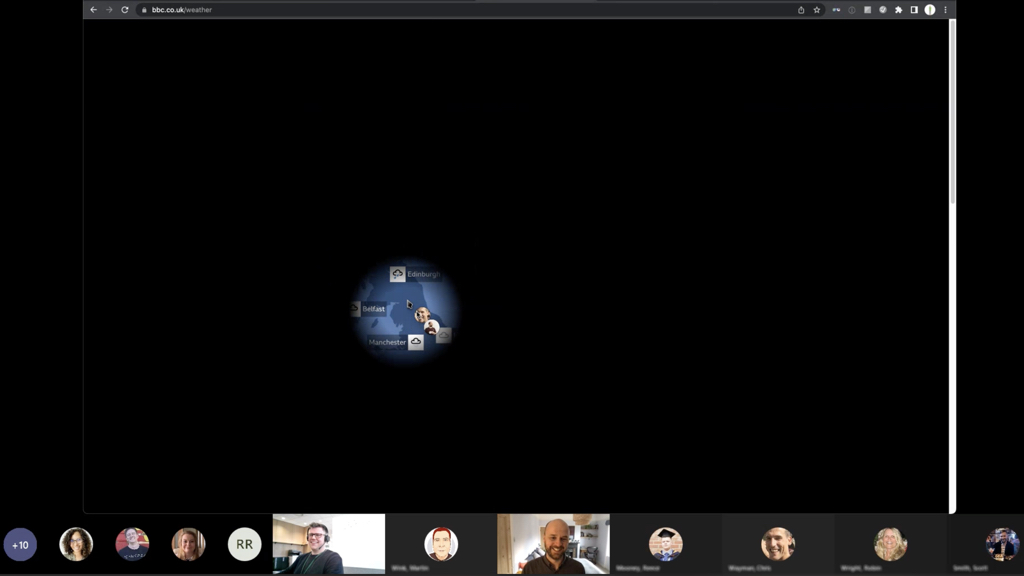
Year three (2023)
May 2023 was on the tail-end of the pandemic, so most operations were still online-only. My aim was to go bigger this year, and although I lost a presentation to a last-minute absence, it was a great day, and included an introductory message from Sage’s Chief Product Officer. Here’s the running order:
- My now-customary introduction to accessibility talk
- A workshop where teams were formed to create an accessible component
- An accessibility empathy lab; now a staple
- ‘Accessibility doesn’t just mean WCAG compliance’, a presentation
- A series of mini-presentations where several Accessibility Champions talked about why accessibility became important to them, and how they incorporate it their roles
The cumulative attendance was slightly down on the year before, at 345, but the average per session was up to 69. If everything had gone as planned we would have been well over 400!
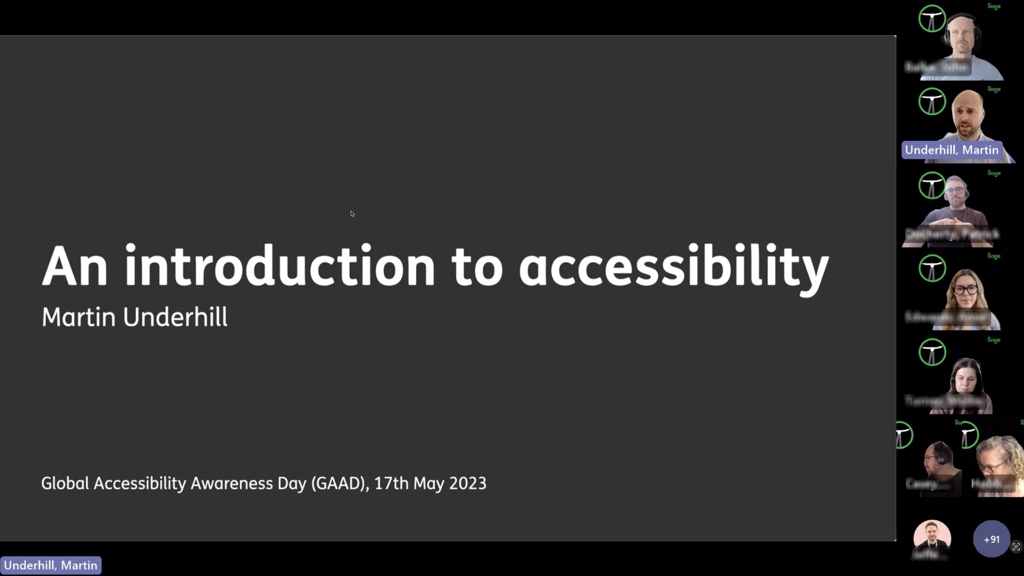
Year four (2024)
2024 was the year we went really big! I say “we”; this one needed a team behind it to work! The pandemic had subsided and people were returning to offices for a couple of days each week. We split this GAAD in two simultaneous events in Sage’s HQ:
- An all-day accessibility empathy lab run by Accessibility Champions
- An in-person conference broadcast globally from the ‘Auditorium’ amphitheatre area
Accessibility empathy lab
With the success of the online empathy labs over the years, I decided an all-day, in-person lab would be a good idea.
I booked a room with around twenty desktop PCs where I set up various simulators; some of them physical, like VINE visual impairment glasses and Cambridge Simulation Gloves, some of them software-based. I printed worksheets with tasks and more context about each impairment, then briefed a team of Accessibility Champions who’d be looking after the Lab.
I managed to find budget for tea, coffee, and biscuits throughout the day, and we had pizzas delivered at lunchtime. We also had stamp cards so the more tasks people tried, the more stamps they got; small prizes at the half way mark, and entry to the grand prize draw when their card was full.
The engagement was great, with 57 participants across the day.
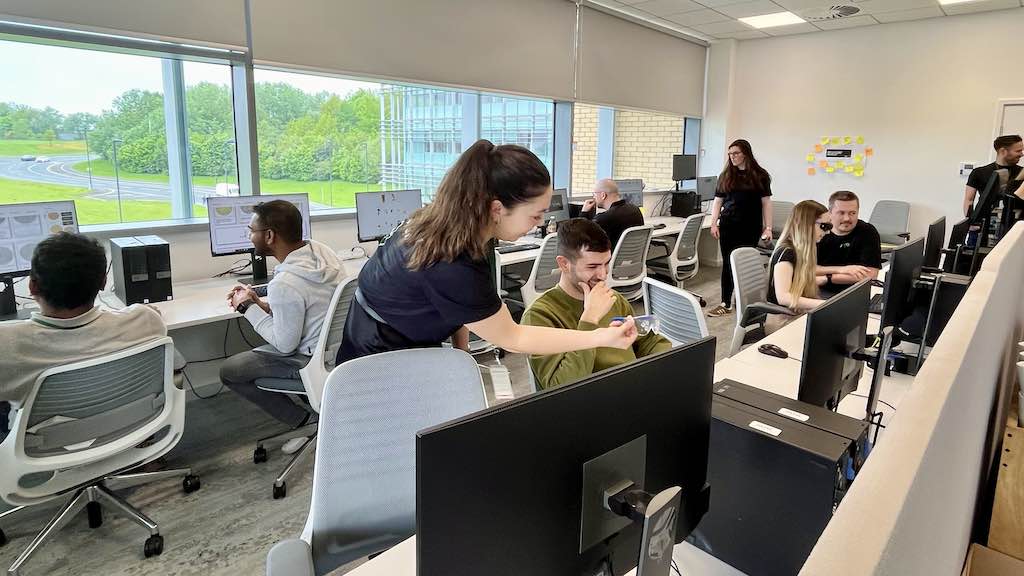
Conference
While the Champions ran the Lab, my team of accessibility specialists and I hosted the conference downstairs. We had sweeties and snacks all day, and a cumulative total of 126 people watching along in the Auditorium. Adding in people who dialled in, we had a cumulative total of 638 people watching over the course of the day, which is around 80 people per session.
Here’s how the day looked:
- An introduction to accessibility, this time delivered by special guests from the Business Disability Forum
- A session explaining the European Accessibility Act in easy-to-understand terms
- An online accessibility empathy lab; this time we arranged for two high-profile senior leaders to carry out the tasks and talk us through challenges as they encountered them
- ‘Overcoming challenges to accessibility’, a roundtable discussion on the various reasons for push-back and how to tackle them
- ‘Five things you need to know about HTML’, a presentation
- An accessibility quiz
- A presentation on how to make the most of your accessibility audit
- ‘My accessibility story’ again; this time in a panel discussion format and with different participants
The conference reached 695 people throughout the day; double the number from year three.
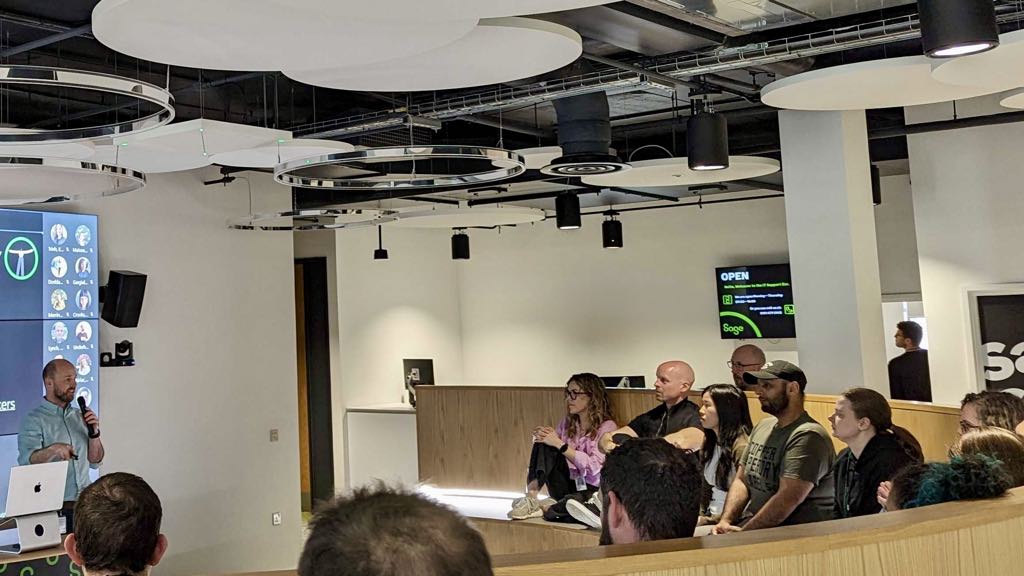
Year five (2025)
GAAD 2025 was the best yet. As part of the initial planning we wondered how we might make it bigger and better than last year, and initially our thoughts were that this year might be the one to broadcast the conference externally to the general public, not just to Sage colleagues.
The other option was to double down on the accessibility empathy labs, leveraging our Champions network, and this was the route we ended up taking.
Rather than running the labs and conference on the same day, our GAAD activities spanned two days:
- Empathy lab day
- Conference day
Empathy labs
We mobilised Champions in 7 offices across the UK, Ireland, and Spain, trained and briefed them so that they were comfortable running the empathy labs themselves, and sent them the kit they needed.
Looking at the numbers from Sage’s HQ specifically, in order to get an idea of year-on-year progress, we engaged with 97 people, which was nearly twice the amount as GAAD 2024. Across all offices, we had 264 participants and lots of great feedback; for example:
I thought I knew about accessibility issues but there’s so much I had not considered.
And:
A solid reminder on why we do what we do for customers of our products and that we must do our best to keep this up.
We also held the traditional online empathy lab on the same day, where we had two more senior leaders, including Sage’s executive sponsor for accessibility; the attendee count was 78, which was our highest ever for an online empathy lab.
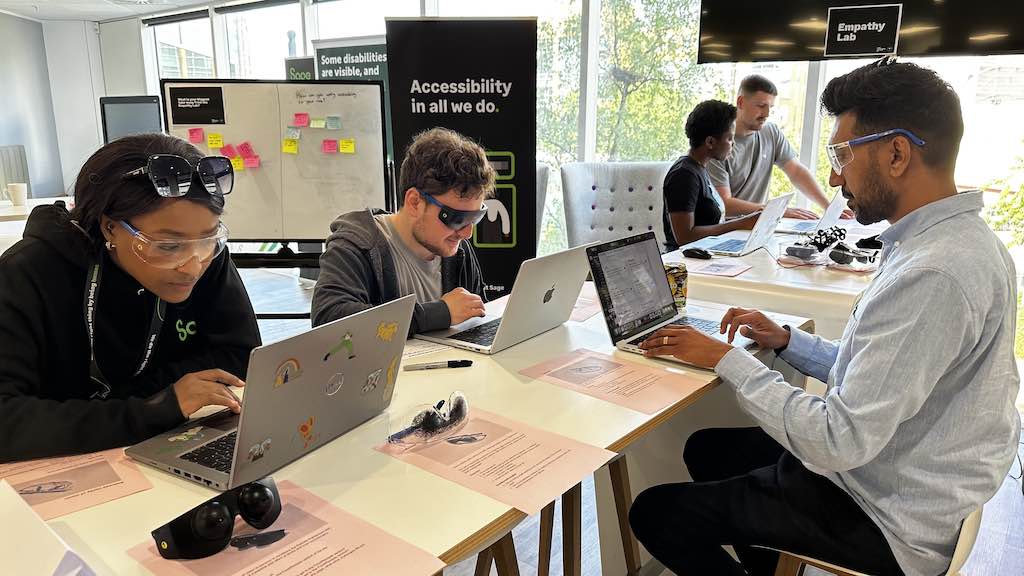
Conference
And of course, there was the conference on the day of GAAD itself. As well as broadcasting from the Auditorium in Sage HQ and people dialling in, we also asked Accessibility Champions to host ‘watch-alongs’ in their offices, which boosted engagement even more. Here’s what we put on:
- My introduction to accessibility
- A follow-on from the last year’s EAA presentation, now that we knew more
- A rundown of the resources for colleagues with access needs
- A presentation detailing a measurable framework for producing an accessible product
- ‘How learning code helps make you a better designer for accessibility’, a presentation
- And accessibility quiz
- ‘How we build components and why accessibility is important’, a presentation
- A presentation on how to embed responsibility for accessibility in every product role
- A roundtable discussion about authentic versus performative accessibility
We totalled 958 cumulative dial-ins, watch-alongs, and in-person attendees. Not bad! That gives an average of 106 people per session.
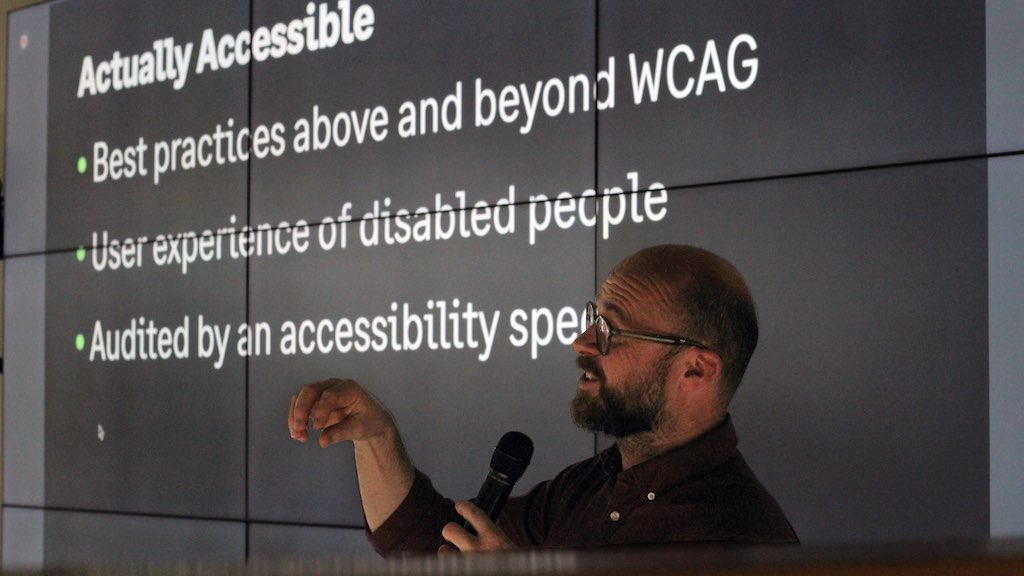
How it grew
Here are those attendance figures:
| Year | Conference | Average per session | Empathy Lab | Total engagement | Year on year increase |
|---|---|---|---|---|---|
| 2021 (year 1) | 86 | 29 | Not applicable | 86 | Not applicable |
| 2022 (year 2) | 388 | 65 | Not applicable | 388 | 451% |
| 2023 (year 3) | 345 | 69 | Not applicable | 345 | −11% |
| 2024 (year 4) | 695 | 80 | 57 | 752 | 218% |
| 2025 (year 5) | 958 | 106 | 264 + 78 | 1300 | 173% |
The jump from year one to year two is the most pronounced; mainly as I had learned how best to promote the activities within the company. From year three onwards, the growth has been both consistent and impressive as:
- the community grew
- the accessibility specialists team grew
- the Accessibility Champions network grew
- we leaned into what we saw working well, in terms of format
Another key factor has been the executive engagement we’ve seen. From year three onwards, senior leaders began participating more actively, attending events, taking part in empathy labs, and even opening the day in some cases. This level of buy-in not only helped boost numbers but also signalled that accessibility was becoming part of our organisational culture.
Every year the activities themselves have received more attention and the community has grown. Five years in, GAAD has become more than an awareness day; it has become a cornerstone of Sage’s accessibility journey.